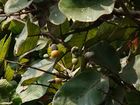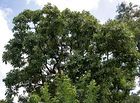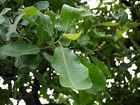Note: This is a project under development. The articles on this wiki are just being initiated and broadly incomplete. You can Help creating new pages.
Difference between revisions of "Semecarpus anacardium - Agnimukh, Marking nut"
(→Identification) |
|||
| Line 3: | Line 3: | ||
==Uses== | ==Uses== | ||
{{Uses|Dyspepsia}}, {{Uses|Strengthen the lungs}}, {{Uses|Arthritis}}, {{Uses|Aphrodisiac}}, {{Uses|Piles}}, {{Uses|Sexual health}}, {{Uses|Skin disease}}, {{Uses|Kapha}}, {{Uses|Destroys worms}}, {{Uses|Wounds}}, {{Uses|Reduce urine flow}}<ref name="Uses"/> | {{Uses|Dyspepsia}}, {{Uses|Strengthen the lungs}}, {{Uses|Arthritis}}, {{Uses|Aphrodisiac}}, {{Uses|Piles}}, {{Uses|Sexual health}}, {{Uses|Skin disease}}, {{Uses|Kapha}}, {{Uses|Destroys worms}}, {{Uses|Wounds}}, {{Uses|Reduce urine flow}}<ref name="Uses"/> | ||
| + | |||
| + | ===Food=== | ||
| + | Semecarpus anacardium can be used in Food. Fresh or dried receptacles of the fruit are eaten raw. Kernel found inside the hard shell is eaten.<ref name="Forest foods of Western Ghat"/> | ||
==Parts Used== | ==Parts Used== | ||
| Line 35: | Line 38: | ||
==How to plant/cultivate== | ==How to plant/cultivate== | ||
| − | Plants are adaptable to a variety of tropical and subtropical conditions | + | Plants are adaptable to a variety of tropical and subtropical conditions<ref name="How to plant/cultivate"/>. Semecarpus anacardium is available through January to May<ref name="Forest foods of Western Ghat"/> |
==Commonly seen growing in areas== | ==Commonly seen growing in areas== | ||
| Line 50: | Line 53: | ||
==References== | ==References== | ||
| − | |||
<references> | <references> | ||
<ref name="chemical composition">[https://www.bimbima.com/ayurveda/ayurvedic-herb-bhallataka-semecarpus-anacardium/331/ Bimbima medicines]</ref> | <ref name="chemical composition">[https://www.bimbima.com/ayurveda/ayurvedic-herb-bhallataka-semecarpus-anacardium/331/ Bimbima medicines]</ref> | ||
| Line 56: | Line 58: | ||
<ref name="Commonly seen growing in areas">[http://www.planetayurveda.com/library/bhallataka-semecarpus-anacardium Planet ayurveda]</ref> | <ref name="Commonly seen growing in areas">[http://www.planetayurveda.com/library/bhallataka-semecarpus-anacardium Planet ayurveda]</ref> | ||
<ref name="Uses">Karnataka Medicinal Plants Volume - 2 by Dr.M. R. Gurudeva, Page No. 256</ref> | <ref name="Uses">Karnataka Medicinal Plants Volume - 2 by Dr.M. R. Gurudeva, Page No. 256</ref> | ||
| − | + | <ref name="Forest foods of Western Ghat">"Forest food for Northern region of Western Ghats" by Dr. Mandar N. Datar and Dr. Anuradha S. Upadhye, Page No.134, Published by Maharashtra Association for the Cultivation of Science (MACS) Agharkar Research Institute, Gopal Ganesh Agarkar Road, Pune</ref> | |
</references> | </references> | ||
Revision as of 13:04, 16 November 2021
Semecarpus anacardium is a native of India. it is found in the outer Himalayas to Coromandel Coast. It is closely related to the cashew.
Contents
Uses
Dyspepsia, Strengthen the lungs, Arthritis, Aphrodisiac, Piles, Sexual health, Skin disease, Kapha, Destroys worms, Wounds, Reduce urine flow[1]
Food
Semecarpus anacardium can be used in Food. Fresh or dried receptacles of the fruit are eaten raw. Kernel found inside the hard shell is eaten.[2]
Parts Used
Chemical Composition
Anacardic acid, cardol, catechol, anacardol and fixed oit, sernicarpoi, bhilawanol.[3]
Common names
| Language | Common name |
|---|---|
| Kannada | Geru, Geru-kayi |
| Hindi | Bealata, Bela, Bhilava |
| Malayalam | Thennukota, Alakcueer |
| Tamil | Kalakam, Kavaka |
| Telugu | Ballatamu |
| Marathi | NA |
| Gujarathi | NA |
| Punjabi | NA |
| Kashmiri | NA |
| Sanskrit | Angika, Agnimukh, Ballataka |
| English | Marking nut |
Habit
Identification
Leaf
| Kind | Shape | Feature |
|---|---|---|
| Simple | Tri-foliolate,lanceolate | Leafs are 2.5-13.5 cm long to 1-5.5 cm wide. The leaflets are green above and a silvery grey-green beneath and are covered on their lower surfaces in small yellow glands |
.
Flower
| Type | Size | Color and composition | Stamen | More information |
|---|---|---|---|---|
| Unisexual | 14cm long | Yellow, papilionaceous | Typical of species belonging to the Leguminosae subfamily Papilionoideae, and resemble, for example, the pea ( Pisum sativum ) flower | Flowering from August to March |
Fruit
| Type | Size | Mass | Appearance | Seeds | More information |
|---|---|---|---|---|---|
| Ovoid | The nut is about 25 millimetres long | The seed inside the black fruit, known as godambi, is edible when properly prepared. | Single seed | Fruiting from August to March |
Other features
List of Ayurvedic medicine in which the herb is used
Where to get the saplings
Mode of Propagation
How to plant/cultivate
Plants are adaptable to a variety of tropical and subtropical conditions[4]. Semecarpus anacardium is available through January to May[2]
Commonly seen growing in areas
Hotter parts, Deciduous forests of the Malaysian archipelago, Northern Australia.[5]
Photo Gallery
References
- ↑ Karnataka Medicinal Plants Volume - 2 by Dr.M. R. Gurudeva, Page No. 256
- ↑ 2.0 2.1 "Forest food for Northern region of Western Ghats" by Dr. Mandar N. Datar and Dr. Anuradha S. Upadhye, Page No.134, Published by Maharashtra Association for the Cultivation of Science (MACS) Agharkar Research Institute, Gopal Ganesh Agarkar Road, Pune
- ↑ Bimbima medicines
- ↑ Trophical plants
- ↑ Planet ayurveda
External Links
- Ayurvedic Herbs known to be helpful to treat Dyspepsia
- Ayurvedic Herbs known to be helpful to treat Strengthen the lungs
- Ayurvedic Herbs known to be helpful to treat Arthritis
- Ayurvedic Herbs known to be helpful to treat Aphrodisiac
- Ayurvedic Herbs known to be helpful to treat Piles
- Ayurvedic Herbs known to be helpful to treat Sexual health
- Ayurvedic Herbs known to be helpful to treat Skin disease
- Ayurvedic Herbs known to be helpful to treat Kapha
- Ayurvedic Herbs known to be helpful to treat Destroys worms
- Ayurvedic Herbs known to be helpful to treat Wounds
- Ayurvedic Herbs known to be helpful to treat Reduce urine flow
- Herbs with Fruits used in medicine
- Herbs with Gum used in medicine
- Herbs with Pericarp used in medicine
- Herbs with common name in Kannada
- Herbs with common name in Hindi
- Herbs with common name in Malayalam
- Herbs with common name in Tamil
- Herbs with common name in Telugu
- Herbs with common name in Sanskrit
- Herbs with common name in English
- Habit - Tree
- Index of Plants which can be propagated by Seeds
- Herbs that are commonly seen in the region of Hotter parts
- Herbs that are commonly seen in the region of Deciduous forests of the Malaysian archipelago
- Herbs that are commonly seen in the region of Northern Australia
- Herbs
- Anacardiaceae





